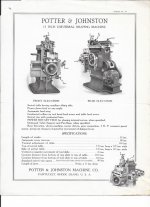Caleb Kullman
Plastic
- Joined
- Jan 21, 2014
- Location
- Santa Fe, NM
I just acquired a 14" (I believe) Potter & Johnston shaper. I have never operated a shaper but would like to start using the machine for a few things. How do I adjust the length of stroke on this machine? Also, I think I understand the power downfeed mechanism but could use a little explanation on how to adjust and set the x axis feed per stroke. Does anyone have a manual or know where I can find one for this thing? Photos are attached.
Thank again,
Caleb
Thank again,
Caleb








